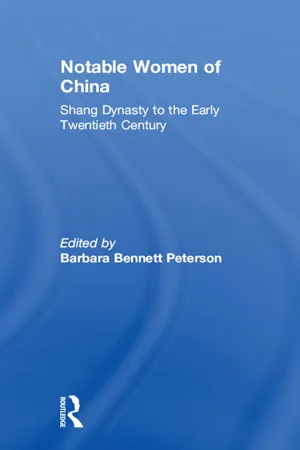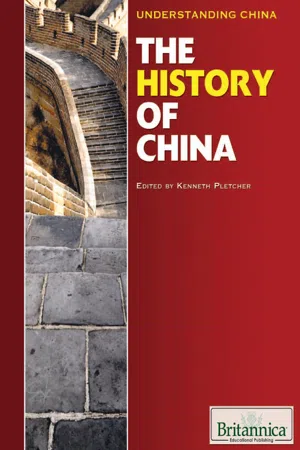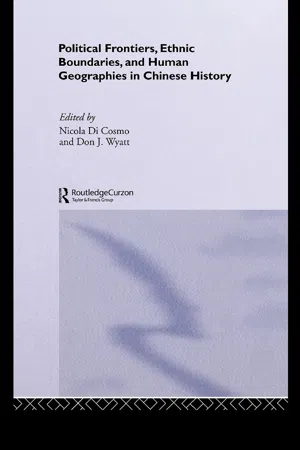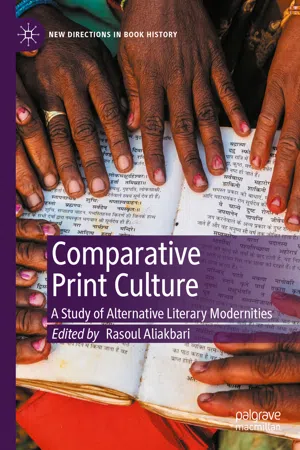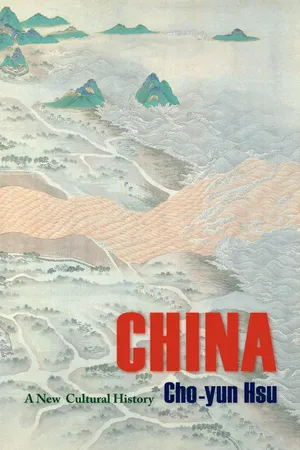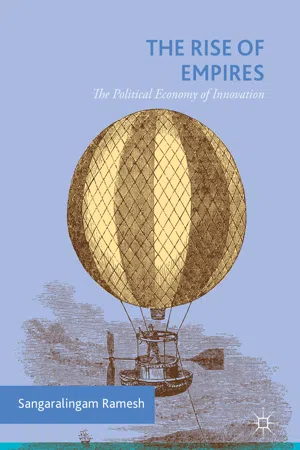History
Song Dynasty
The Song Dynasty was a major period in the history of China, lasting from 960 to 1279. It is known for significant advancements in technology, arts, and culture, including the development of movable type printing, gunpowder, and porcelain. The dynasty also saw the rise of Neo-Confucianism as the dominant intellectual and philosophical system.
Written by Perlego with AI-assistance
Related key terms
11 Key excerpts on "Song Dynasty"
- eBook - ePub
Harmony and War
Confucian Culture and Chinese Power Politics
- Yuan-kang Wang(Author)
- 2010(Publication Date)
- Columbia University Press(Publisher)
3 THE NORTHERN Song Dynasty (960–1127)THE SONG dynasty is known for its extraordinary cultural achievements in literature, art, and philosophy. Confucianism was refined and reinterpreted, thereby giving rise to neo-Confucianism, which became the orthodox ideology for statecraft and elite education. Dieter Kuhn calls this period “the Age of Confucian Rule.”1 Cultural achievements aside, the Song made several advances in science and technology. The Song’s three great inventions—gunpowder, the compass, and printed books—would later have a profound impact on human history. The Song civilization was so ahead of the rest of the world that John K. Fairbank calls it “China’s greatest age.”2 However, in terms of military power, epithets such as “perennially weak and unable to rise” (ji ruo bu zhen) or “emphasizing civility and belittling martialism” (zhong wen qing wu) are habitually attached to the Song Dynasty. Unlike other Chinese dynasties, the Song never achieved military dominance and was instead threatened with the prospect of foreign invasion and even conquest. Because the Jurchens invaded and conquered part of the Song Dynasty’s territory in 1127, capturing two emperors, historians generally divide the Song period into the Northern Song Dynasty (960–1127) and Southern Song Dynasty (1127–1279).The power structure during this period was largely bipolar. The sedentary Song Dynasty was under constant military threats from the nomadic Liao Empire to the north, which historian Jing-shen Tao describes as “the most powerful state in East Asia at the time.”3 (See map 3.1 .) According to one statistic, the Liao Empire had a strong cavalry force of 500,000 men, outnumbering the Song Dynasty’s 193,000 cavalry and infantry by more than two and a half to one.4 China was a “lesser empire” in the interstate system,5 but neither was powerful enough to dominate East Asia. Unlike other periods of Chinese history in which formal equality between China and its neighbors was ruled out, the Song-Liao diplomatic relationship was conducted as one between two equal states.6 - eBook - ePub
Notable Women of China
Shang Dynasty to the Early Twentieth Century
- Barbara Bennett Peterson(Author)
- 2016(Publication Date)
- Routledge(Publisher)
Part V The Song and Yuan Dynasties Revitalize ChinaDOI: 10.4324/9781315702063-5During the Song Dynasty (960–1279 a.d .), emperors and women of the imperial court revitalized China initially under the leadership of General Kuangyin, who became the dynasty’s first emperor and established his capital at Kaifeng. This dynasty reunified China after the period of the Ten Kingdoms which dominated South China and the Five Dynasties, which had dominated the North following the fall of the Tang dynasty. The emperors readopted the policy of paying annual tribute to the Khitan Tatars in Liao of 100,000 ounces of silver and 200,000 pieces of silk. The Khitans established the Liao dynasty in areas of northern China between 947 and 1125 a.d . The fall of the Tang dynasty had left China vulnerable to these external disorders during the so-called Five Dynasties period, in which warlords competed. But Kuangyin had restricted the power of his commanders and relied upon civil officials. The Song had subdued the secessionist states of the south, but they continually had problems in the north, hence the payment of the annual tribute and the appeasement of the Khitans and the Liao dynasty’s rulers. All Song military forces were placed under the command of the Emperor’s court, limiting warlordism.The central government had regained power and during the Song Dynasty there were advances in medicine such as inoculation against diseases including smallpox and the invention of the magnetic compass. During this period the Chinese developed accurate maps of the world, excelling in cartography and relief maps.The Song Dynasty unfortunately also saw the introduction of female foot binding, which relegated women to an ornamental status in a wealthy economy. This cruel custom molded the foot into a lily shape by binding the toes backward with cloth strips. Women of the upper classes, appearing dainty-footed, adopted this style for themselves and their daughters; in addition to being painful, this custom severely limited their freedom of movement outside the house and kept them in a subordinate status. But, thus “handicapped,” these women did not have to work, illustrating their membership in the elegant, refined, upper classes. - eBook - ePub
- Britannica Educational Publishing, Kenneth Pletcher(Authors)
- 2010(Publication Date)
- Britannica Educational Publishing(Publisher)
sanqu . Of greatest influence on scholar-officials in succeeding generations was a masterly prose style that was original and creative but was always used in the name of reviving ancient models. Diversified and specialized developments widened knowledge so much that scholars compiled voluminous histories, collected works, comprehensive handbooks, compendiums, and encyclopaedias. Fine arts also reached new heights.The term early modern has often been applied in describing Song culture, because it not only advanced beyond the earlier pattern in China and far ahead of the rest of the world at the time but also had many startlingly new features that approximated later developments in western Europe. This characterization, though helpful to highlight and appreciate the progress during Song times, is somewhat misleading, since this stage of development did not pave the way for more modernity later. On the contrary, the Song pattern attained cultural stability, giving rise to the myth of an unchanging China.These conflicting images stemmed from the cultural and regional diversity of the Song, in which modern-style advances existed alongside continuing older practices. In some areas, such as the delta lands immediately south of the Yangtze River, sizable estates grew up with a complicated social pattern characterized by tenant farming. Elsewhere, in areas less well-developed, owner-farmers constituted a greater proportion of the population, while in other regions the landlords tried to bind the tillers to the soil. The same confusion was reflected in the status of women. During the Song the notorious practice of foot binding first became common, clearly marking a fall in the status of women, but there is evidence that during the Nan Song (unlike any other Chinese dynasty) daughters as well as sons could inherit property in their own names. Furthermore, Song families tried in various ways to strengthen the ties created by the marriages of their daughters to other families. - eBook - ePub
How to Read Chinese Poetry
A Guided Anthology
- Zong-qi Cai(Author)
- 2007(Publication Date)
- Columbia University Press(Publisher)
The latter period began with the invasion of the Jurchen armies in the 1120s and the consequent withdrawal of the Chinese court to the south and loss of the northern half of the empire to foreign rule. More important to our discussion than the military weakness of the Song, however, is the fact that it was during this period that book printing became widespread in China. Largely for that reason, the amount of writing that survives from the three hundred years of the Song surpasses by far that of any previous dynasty; probably it exceeds the total of all the previous dynasties. The amount of Song Dynasty shi poetry is staggeringly large. Some 200,000 poems survive, composed by nearly 10,000 authors. (Quantitatively, at least, shi is the major Song poetic genre, dwarfing in size the younger and less prestigious form of the ci [song lyric].) Very few people can have read all of the shi corpus. The quantity of shi poetry produced is so daunting that it was not until the end of the twentieth century that anyone set about to collect all of it. It required a national effort by a team of dozens of scholars in China and ten years of editorial labor to complete the project: Complete Shi Poetry of the Song (Quan Song shi). 1 The poetry of the preceding great dynastic period, the Tang, is by comparison more manageable and much better known. There has been a Complete Shi Poetry of the Tang (Quan Tang shi) since 1706—that is, for three hundred years—and it is less than one-quarter as voluminous. 2 The literary history and criticism of Tang poetry is well developed. The serious study of Song poetry as a whole is still in its initial stages. Nevertheless, it has long been fashionable, ever since the Song itself, for poets and critics to think of the poetry of the Song as stylistically distinct from that of the Tang, and to debate its merits relative to the earlier work - eBook - ePub
- F. W. Mote(Author)
- 2003(Publication Date)
- Harvard University Press(Publisher)
6II. ON BEING THE EMPEROR IN TENTH -CENTURY CHINAThe Chinese government, in all dynasties from the Qin in the late third century b.c.e. until the end of the Qing in 1911, was headed by a huangdi, a supreme ruler whose title we translate as “emperor.”7 His roles were many: he was the state’s sole legislator, ultimate executive authority, and highest judge. His pronouncements were, quite literally, the law, and he alone was not bound by his own laws. The emperor was ritual head of the state, analogous to the head of every Chinese clan or lineage, by which every person in society was bound to a surname and to family responsibilities. As the head of the imperial clan, he thus was a model for the maintenance of the atomized, family-based ancestor veneration that held priority among all the forms of religion in the society. And the emperor was held to embody and to have responsibility for upholding all the values of the society. But he was not expected to assume such responsibilities in an open, public manner. He did not interact personally with any sector of society, and did not play a significant political role in public life.There were two kinds of restraints on the Chinese emperor’s seemingly boundless authority: those were ideological and practical. Ideologically, China’s rulers, some more effectively than others, were constrained by Confucian norms and the values perpetuated by the scholar-official elite of society. In these respects his authority, while enormous, was not unchallengeable, especially in matters of ethics and of principle that were defined by scholarly interpretations of the past. It might indeed take a brave person to challenge an emperor, who, if he insisted, would prevail. Yet there were many throughout history who had the courage to challenge their rulers on grounds of tradition and classical learning, or in matters of ethics. Song Dynasty emperors were unusually broadminded in respecting their scholar-official associates in governing, but they too were despots, whether benign or tyrannical, depending on temper and other contingent circumstances. - Nicola Di Cosmo, Don J Wyatt(Authors)
- 2005(Publication Date)
- Routledge(Publisher)
I have always found the unfaltering confidence with which my sinological contemporaries refer to the period from the dynastic founding by Zhao Kuangyin (Song Taizu) in 960 until the first complete year of the reign of Emperor Qinzong (r. 1125–7) as the Northern Song to be perplexing. As a group, following in the wake of untold previous generations of scholars, we have – without significant reflection or deliberation on the matter and almost purely by dint of the existence of the corresponding term that denotes it – assumed the existence of the Northern Song. Moreover, we have thereby become unwitting but active participants in an always potentially graver act of ascription only by imputation. We have – with even less caution and examination than we have come to subscribe to the notion ourselves – evolved to speak of the Northern Song as if it were as real to and accepted by those living during its span as it has become for us. But, in addition to its seeming to spring from nowhere, such a designation as Northern Song belies the fact that the Chinese citizenry of that era would neither plausibly nor willingly have ever referred to the reigning dynasty during their own time by that name. Despite considerable external pressures to do so, no individual of that time is likely to have ever overtly considered the dynasty under which he or she lived “northern,” for the designation Northern Song can only have arisen after the sudden and involuntary creation of the Southern Song (Nan Song). Moreover, even the Chinese of this subsequent and, at least in geographical terms, more legitimately termed Southern Song period persisted in regarding their displaced dynasty as the uninterrupted continuation of the original Song – with no thought, at least at first, to construing it as the beginning of a new epoch- eBook - ePub
- William Guanglin Liu(Author)
- 2015(Publication Date)
- SUNY Press(Publisher)
Part IIThe Song Era
Passage contains an image Chapter 3
How Large Was the Money Economy?
The first major characteristic observed from long-term economic changes in China is the existence of two contrasting economic cycles during the six intervening centuries between 900 and 1500. During the Song era from 960 to 1120, population growth and market development engineered economic expansion to an unprecedented level. This expansive cycle, however, halted after 1200. The Mongol conquest in the thirteenth century caused a radical decline in the Chinese aggregate population and devastated the economy in North and Central China. The retreating cycle worsened during the succeeding two centuries by the establishment of a command economy and by all kinds of anti-market policies that the early Ming court implemented.The fourteenth-century turning point thesis held by Elvin, Skinner, and Hartwell explicitly takes demographic change as the major cause for the making of these two cycles and assumes the economy would have recovered to the same level when the population reached the same size.1 This assumption is highly problematic and rather misleading when applied to the performance of the early Ming economy. Despite the close connection between population decline and the major trend in price movements, a shrinking in the size of the market economy was even more dramatic than the decline in the population. The following three chapters are aimed to provide a comprehensive survey of the two cycles based upon quantitative evidence. Chapter 4 focuses on the expansion of the Kaifeng-centered waterway transportation network in the eleventh century, and this investigation strongly supports the Song commercial revolution thesis. Chapter 5 - eBook - ePub
Comparative Print Culture
A Study of Alternative Literary Modernities
- Rasoul Aliakbari, Rasoul Aliakbari(Authors)
- 2020(Publication Date)
- Palgrave Macmillan(Publisher)
2002 , 84).3 Song Neo-Classicism and “Modern” Editions of Han and Liu
All of the above summary is common knowledge to specialists in Chinese print history, and in Song Dynasty literature. Generations of Chinese scholars have already done foundational work in establishing the lineages of certain editions, and the motivations underlying Northern Song classicist movements. For the most part, the sort of print culture studies which have become central to Western scholarly discussion in the past few decades have been pursued in English (and occasionally in other European languages). Even these have tended to focus on the later Ming and Qing dynasties, when print culture was much more highly developed, and had helped create robust markets in vernacular fiction and drama. However, there have also been a number of important recent studies, starting with Susan Cherniack ’s ground-breaking work on the relationship of issues of transmission and circulation of texts to larger trends in Song book culture. Sometimes scholars working on longer surveys, such as Joseph McDermott and Lucille Chia have included valuable sections on Song materials. But, in particular, Hilde de Weerdt has been extremely active in examining early Song printing, and while all of her various publications cannot be mentioned here, a recent edited volume by De Weerdt and Chia has brought together a wealth of different perspectives on how print touched on book collection, religion, medicine, and historiography in the Song and succeeding dynasties.Across the various research of people who have worked on the Northern Song, there is an initial consensus forming about the highly partial character of print in the period. Some scholars in Song studies are uncomfortable claiming that this period possessed a true print culture, because manuscript culture remained central to intellectual life during this period—and indeed, long after. And there is a diversity of opinion as to whether the economics of print at this relatively early period can actually be said to have constituted a substantial change in the way that books affected relations between books and readers.3 Manuscript and print collections interacted in various ways—with most collectors possessing works in both manuscript and print, and using both manuscript and print editions of works to edit and collate new editions, as well as for general reading, research, and composition of new works. Manuscript was a part of the print process: with woodblock - eBook - ePub
China
A Religious State
- Cho-yun Hsu, John Lagerwey, Timothy Baker, Jr., Michael Duke, Joseph Y. S. Cheng(Authors)
- 2012(Publication Date)
- Columbia University Press(Publisher)
Song villages often had village compacts (xiangyue, sheyue), in which membership was established on the basis of the Confucian tradition of respect for family and neighbors. Confucian ethical concepts were deeply embedded in popular society, and this made scholars important members of these village-compact organizations. The people of the Song had a neoclassical turn of mind; they made copies of ancient ritual vessels (liqi), and their officials advocated ancient rites (li).One of these ancient rites was a village drinking ceremony in which common people offered their respect to the educated stratum. The high respect in which the Chinese educated stratum was held in late imperial times began in the Song Dynasty and returned in the Ming and Qing after a temporary decline during the Mongol Yuan dynasty. 6. Pluralism and Integration in Late Medieval Thought Confucianism (Rujia) and Daoism (Daojia) were the mainstream of Chinese thought, but over the several hundred years since the introduction of Indian Buddhism during the Han dynasty, the medieval era witnessed a great deal of accommodation and blending of these three currents of thought. Buddhism and religious Daoism often experienced persecution, however, especially under Emperor Wudi of the Northern Zhou (r. 560–578) and the Tang emperor Wuzong (r. 840–846), when Buddhist monks and monasteries suffered very greatly. Some organizations inspired by religious Daoism were militarily suppressed because of their violent anti-government activities. The early Daoist religious sects of the Way of Heavenly Peace (taipingdao) and Celestial Master Daoism (tianshidao) and the many religious secret societies (like those of Li Shun and Hundred Year Li) frequently arose to resist the government - eBook - ePub
The Rise of Empires
The Political Economy of Innovation
- Sangaralingam Ramesh(Author)
- 2018(Publication Date)
- Palgrave Macmillan(Publisher)
The Song was the first dynasty in China to rely on commercial activity for tax revenues, rather than the agricultural sector. 106 To encourage commercial activity, the Song government either did not raise taxes, or it chose to lower it. 107 Merchants kept accounts to determine whether they were making a profit or a loss from their business activities. A four-column reporting system, developed in the Tang dynasty, was used and elaborated upon throughout the Song period. 108 According to the latter, the equation identified with this system was (old + newly received= payment + balance). 109 The government also published annually a book on national accounts and accounts. 110 Due to the level of commercial activity and economic growth, there were more and more financial accounts to record and balance. As a result, the accounting system during the Song Dynasty became more sophisticated than at any other time in traditional Chinese history. 111 Nevertheless, developments in accounting systems were less at the start of the Song Dynasty. But the pace of development increased as commercialism took hold. 112 The latter suggests that increasing commercial activity brought credit sales into fashion. In conjunction with the issuing of paper money by the Song government, there was a need for accounting systems to change in order to incorporate these developments. There was no political ideology which could explain this detachment of tax revenues from the land. 113 However, unlike previous dynasties, the Song were more reliant on market forces to resolve social welfare. Nevertheless, beginning during the Song period, the concept of the ‘clan’ became very important in Chinese society. 114 The clan provided the welfare support, which the Song state never did. 115 The latter suggests that the clan was also responsible for tax collection, dispute resolution, the conduct of its members, as well as the preparation of clan members for the civil service entrance exams - eBook - ePub
Asia in Western and World History: A Guide for Teaching
A Guide for Teaching
- Ainslie T. Embree, Carol Gluck(Authors)
- 2015(Publication Date)
- Routledge(Publisher)
But the Song government’s payments to the northern states amounted to about 1 percent of its annual military budget, and in turn helped to prime the pump of a trade that was enormously imbalanced in the Song’s favor. As to the Mongols, that the Southern Song was able to hold out for forty years against an enemy that up to that time had conquered quickly wherever it had exerted sustained effort, and that the final conquest was achieved with naval and artillery technology borrowed from the Song, suggests military strength more than weakness. For the first and last time in imperial Chinese history before the nineteenth century, a Chinese state acted within a multistate system of rough military equals, and did so with skill and flexibility, engaging in sophisticated diplomacy and concluding treaties that assumed formal equality of partners. There is an unappreciated success story here. Yet to turn to the state, which has not much occupied our attention so far, raises issues important for any comparison of Europe and Asia and for any notion of Song “modernity.” A critical feature of European developments in the last several centuries, after all, has been the building of nation-states, entailing the extension of state power deeper and deeper into the everyday lives of subjects, the bureaucratization both of internal state structures and of state-subject relations, and so on; and this—not commercialization and industrialization alone—is a significant part of our broad notion of “modernity.” But it is in precisely this sphere that Song Chinese developments may most differ from European. Bureaucracy was very old in China, and the Song state appears to be not only an effectively centralized bureaucracy but a very large and powerful state in comparison to its Western contemporaries. But in its direction of change it may represent a key point in a trend virtually opposite to the line Western states, or those that have survived, have traced. As G
Index pages curate the most relevant extracts from our library of academic textbooks. They’ve been created using an in-house natural language model (NLM), each adding context and meaning to key research topics.

